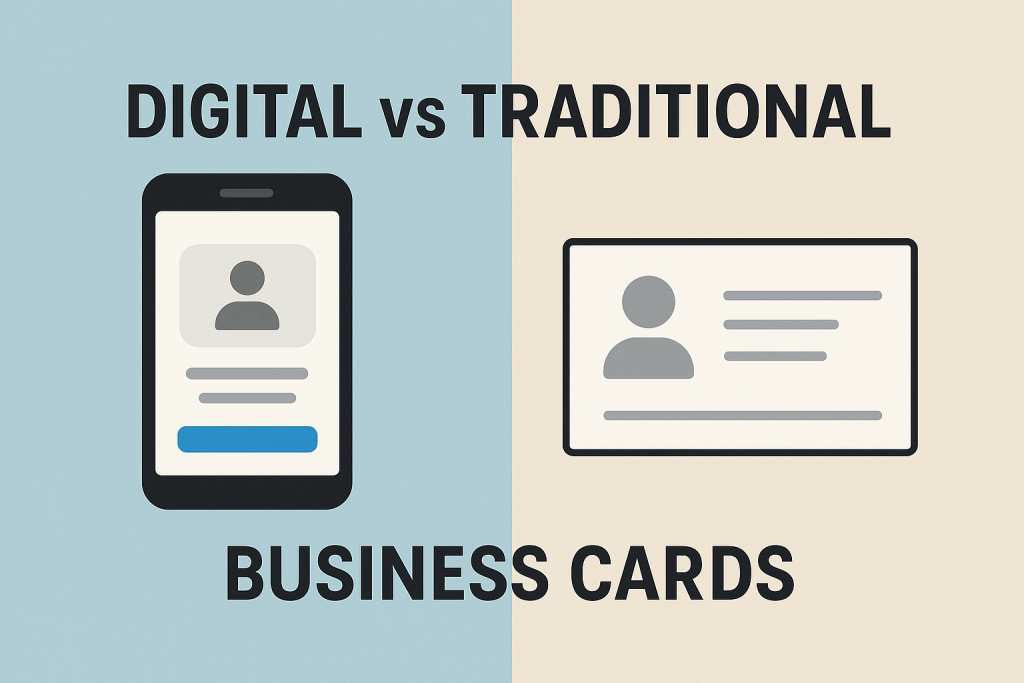Business cards have long been a powerful tool in professional networking, helping individuals establish connections and exchange contact details seamlessly. Whether you’re at a corporate event, conference, or an impromptu meeting, having a business card on hand can make a lasting impression.
With advancements in technology, digital vs traditional business cards have become a topic of discussion for professionals looking for the most efficient way to network. While traditional paper business cards have been the norm for decades, digital business cards vs paper cards offer a modern, eco-friendly, and interactive approach .In this article, we will explore the business card comparison between digital and traditional options to help you determine the best business cards for networking and which one suits your needs.

What is a Digital Business Card?
A digital business card is an electronic alternative to traditional paper business cards. It allows professionals to share their contact information, social media profiles, and business details digitally via a QR code, email, NFC technology, or a dedicated link.
Key Features of Digital Business Cards:
- Instant sharing through QR codes, email, or social media.
- Multi-platform integration with LinkedIn, email, phone numbers, and websites.
- Customizable and interactive with images, videos, and clickable links.
- Environmentally friendly, eliminating paper waste.
Pros of Digital Business Cards
- Easy to update without the need for reprinting.
- Provides more information and interactivity than paper cards.
- Cost-effective with no recurring printing expenses.
- Some platforms offer analytics to track views and engagement.
Cons of Digital Business Cards
- Requires internet access for sharing and viewing.
- Not always accepted in traditional networking settings.
- Dependent on smartphones or compatible devices.
Platforms like InfoProfile provide seamless and intuitive solutions for creating professional digital business cards, making networking effortless.
What is a Traditional Business Card?
A traditional business card is a physical, printed card that professionals hand out during meetings and events. It typically contains essential information such as name, job title, company details, phone number, email, and sometimes a logo.
Materials Used in Traditional Business Cards:
Traditional business cards are commonly made from:
- Cardstock Paper – Durable and cost-effective.
- Plastic Cards – Waterproof and long-lasting but more expensive.
- Metal Business Cards – Premium and unique but costly.
- Recycled Paper – A sustainable alternative for eco-conscious professionals.
Pros of Traditional Business Cards
- Tangible and personal, leaving a lasting impression.
- No technology is required for sharing or viewing.
- Widely accepted in formal business settings.
Cons of Traditional Business Cards
- Limited space for contact details and branding.
- Prone to loss, damage, or being discarded.
- Ongoing printing costs add up over time.
- Contributes to environmental waste due to paper usage.
Business Card Comparison: Digital vs Traditional Business Cards
To help you decide, let’s do a business card comparison between digital vs traditional business cards based on key factors:
Comparison Table: Digital vs Traditional Business Cards
| Aspect | Digital Business Cards | Traditional Business Cards |
Ease of Sharing | Instantly share via QR codes, NFC, or links. | Must be physically handed over. |
| Updateability | Instantly update details without reprinting. | Requires reprinting for any change. |
| Networking Efficiency | Can be shared worldwide in seconds. | Only useful in face-to-face meetings. |
| Cost | One-time creation, no printing costs. | Printing and reprinting costs over |
| Eco-Friendliness | 100% digital, no paper waste. | Contributes to paper waste. |
As seen in the business card comparison, digital cards provide flexibility, efficiency, and sustainability, whereas traditional cards still hold their place in face-to-face networking.
Why Digital Business Cards Are Best for You
If you’re looking for the best business cards for networking, digital business cards vs paper cards offer several compelling advantages:
1. Easy to Share & Access
A digital business card can be shared instantly via QR code, text, or email—perfect for fast-paced networking events or virtual meetings.
2. Instant Updates
With digital vs paper cards, updating information is seamless. If your phone number, email, or job title changes, there’s no need for reprinting—simply update it in real time.
3. Cost-Effective Solution
Unlike traditional cards that require ongoing printing expenses, digital business cards offer a one-time setup cost, making them a smart financial choice.
4. Sustainable & Eco-Friendly
Going digital eliminates the need for paper, contributing to sustainability efforts and reducing waste—an important consideration for modern businesses.
5. Enhanced Features for Better Networking
Digital business cards allow for clickable links, embedded videos, and even integration with CRM tools. This added functionality enhances your networking potential.
Platforms like InfoProfile offer innovative solutions for digital business cards, ensuring that professionals can seamlessly create and manage their networking presence with ease.
Conclusion
Both digital vs traditional business cards have their strengths. If you want a business card comparison that balances modern technology with traditional professionalism, using both can be a strategic approach.
However, for professionals seeking an efficient, cost-effective, and eco-friendly networking solution, digital business cards vs paper cards clearly indicate that going digital is the future. With features like instant updates, seamless sharing, and rich interactivity, digital business cards are redefining how professionals connect.As networking continues to evolve, InfoProfile makes it easier than ever to create, manage, and share the best business cards for networking in a digital-first world. So, is it time to make the switch?



